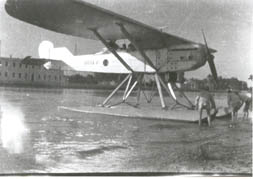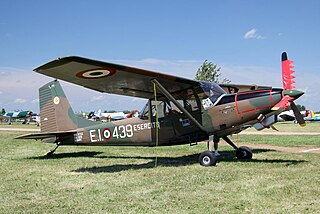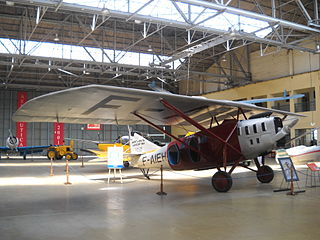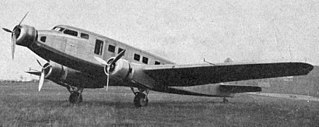Related Research Articles
The Titan T-51 Mustang is a three-quarter scale replica of the P-51 Mustang that was designed by Titan Aircraft owner John Williams. It is a two-seat homebuilt aircraft with dual controls and tandem seats, and has remarkable performance given the small size of the engine.

The Agusta AZ.8L, or Agusta-Zappata AZ.8L, was an Italian airliner prototype first flown on 9 June 1958. It was of conventional low-wing monoplane configuration with tricycle undercarriage and all-metal construction. Filippo Zappata's design grew out of a twin-engined transport designated AZ.1 that was never built.

The Avia BH-29 was a trainer aircraft built in Czechoslovakia in 1927, in the hope of marketing it to both the Czechoslovakian Army, and to Czechoslovakian Airlines as a primary trainer. It was an conventional design, an unequal-span biplane of wooden construction and with tailskid undercarriage. The pilot and instructor sat in tandem open cockpits. A more powerful version was built, powered by a 120 hp (89 kW) Walter NZ-120 radial engine.

The Fokker F.25 Promotor, first flown in 1946, was a single-engined, twin-boomed, four-passenger monoplane with a pusher engine mounted at the rear of a central nacelle. It was of wooden construction and has fitted with a retractable nosewheel undercarriage. One feature of the design was that instead of a 2 + 2 seating, the pilot sat in front to the left, and all three passengers were on a bench seat to the rear of him. Alternatively, when being used as an air ambulance aircraft, it could carry a patient on a stretcher, which was loaded through a hatch in the aircraft's nose. The F.25 was evocative of the pre-war G.I design. The F.25 was based upon the design of the Difoga 421 aircraft, home-built and -designed during World War II by Frits Diepen, a Ford garage owner from Tilburg, the Netherlands. His intention was to create an easy to fly personal aircraft. Due to the war an aircraft engine was not available and instead it used a Ford V-8.

The Breda A.7 was a reconnaissance aircraft developed in Italy for use by the Regia Aeronautica in 1929. It was a braced parasol monoplane of conventional configuration with tailskid undercarriage. The pilot and observer sat in tandem, open cockpits. A single prototype of a long-range example, originally designated A.7 Raid and later A.16 was also constructed, but the air force showed no interest in it.

The Focke-Wulf A 20 Habicht was an airliner developed in Germany in the late 1920s. It was a high-wing cantilever monoplane with fixed tailskid undercarriage. The fuselage was deep and seated four passengers in a fully enclosed cabin. The type was not bought by the airlines and only a few examples were built.

The SIAI-Marchetti SM.1019 is an Italian STOL liaison monoplane built by SIAI-Marchetti for the Italian Army, and based on the Cessna O-1 Bird Dog.

The Jurca Gnatsum is a French homebuilt near scale replica aircraft based on the North American P-51 Mustang.

The Jurca MJ-5 Sirocco is a two-seat sport aircraft designed in France in the early 1960s and marketed for homebuilding. It is one of many wooden homebuilt designs from Romanian born designer Marcel Jurca. Jurca, a Henschel Hs 129 pilot in World War II marketed the plans in Canada and America through Falconar Aviation. It is a low-wing cantilever monoplane of conventional configuration and wooden construction throughout. The tandem seats are enclosed by a bubble canopy, and the tailwheel undercarriage can be built as either fixed or with retractable main units. Marcel Jurca died on 19 October 2001, at which time plans were still available from the designer's web site.

The Jurca MJ-8 1-Nine-0 is a sport aircraft designed in France in the mid 1970s as a replica of the Focke-Wulf Fw 190 and marketed for homebuilding. It is one of many wooden homebuilt designs from Romanian born designer Marcel Jurca. Jurca was a Henschel Hs 129 pilot in World War II who started designing aircraft after building a Jodel. Plans for two versions were produced, the MJ-8, at 3/4 scale, and the MJ-80, at full-scale. Construction throughout is of wood, and the builder may choose to complete the aircraft with either a single seat or two seats in tandem. The plans were marketed by Falconar and later Jurca Plans West.
The Jurca MJ-9 1-Oh-Nine is a sports aircraft designed in France in 1972 as a replica of the Messerschmitt Bf 109 and marketed for homebuilding. It is one of many wooden homebuilt designs from Romanian born designer Marcel Jurca. Jurca was a Henschel Hs 129 pilot in World War II who moved to France in 1948. Plans for two versions were produced, the MJ-9, at 3/4 scale, and the MJ-90, at full-scale.
The Jurca MJ-10 Spitfire is a sport aircraft designed by Marcel Jurca in France as a replica of the Supermarine Spitfire and marketed for homebuilding. Plans for two versions were produced, the MJ-10, at 3/4 scale, and the MJ-100, at full-scale. Construction throughout is of wood, and the builder may choose to complete the aircraft with either a single seat or two seats in tandem. The version represented is the Mk.IX Spitfire, but allowances are made to allow the builder to portray other versions, in particular the Mk.Vc and the Mk.XIV. Additionally, the MJ-100 version may be built with a fuselage structure of welded steel tube if desired. Plans for both versions were marketed by Falconar and later Jurca Plans West.
The Jurca MJ-14 Fourtouna was a racing aircraft designed by Marcel Jurca in France in the late 1970s. It was an unconventional, low-wing cantilever monoplane with retractable tailwheel undercarriage. The fuselage had a low profile that required the pilot to sit in a reclined position. The vertical stabiliser was very small, but aft of the cockpit, the fuselage changed shape from being low and broad to being high and narrow. None have been completed.

The Latécoère 25 was a French airliner built in 1925 for use on Latécoère's own airline and its subsidiaries. Essentially a refined version of the Latécoère 17 with an enlarged wingspan, it supplanted that type in production and then in service.
The Piel CP.90 Pinocchio II was a single-seat, single-engine aerobatic sport aircraft developed in France and marketed for homebuilding. The design was based on that of Piel's Emeraude and was unrelated to Piel's first design named Pinocchio, the CP.10 and indirectly to the second, the CP.20. It was a cantilever, low-wing monoplane of conventional design with an enclosed cockpit and fixed, tailwheel undercarriage. Construction was of wood throughout.

The Jurca MJ-2 Tempete is a single-seat sport aircraft designed in France in the mid 1950s and marketed for homebuilding.

The Bloch MB.300 Pacifique was a French all-metal three-engine monoplane that was developed to enter service as an Air France airliner. Though a single prototype was produced by Société des Avions Marcel Bloch in 1935, it was eventually rejected by Air France circa 1938.
The Jurca MJ-51 Sperocco is a plans-built two-seat tandem aerobatic aircraft derived from the Jurca MJ-5 Sirocco.
The SECAT RG-75 was a light utility monoplane built in France shortly after World War II. It was a conventional cabin monoplane with two seats side-by-side. The wing was mounted high and was of fully cantilever design. The conventional undercarriage consisted of two fixed, divided main units plus a fixed tailskid. Power was supplied by a tractor-mounted piston engine that drove a two-bladed propeller. Construction was of wood throughout, covered in plywood.
The Stewart S-51D Mustang is an American aerobatic homebuilt aircraft that was designed by Jim Stewart and produced by Stewart 51 of Vero Beach, Florida, introduced in 1994. When it was available the aircraft was supplied as a kit for amateur construction.
References
- ↑ Nick Stasinos (February 1972). "Marcel's Mini Fighters". Plane & Pilot.
- Taylor, Michael J. H. (1989). Jane's Encyclopedia of Aviation. London: Studio Editions. p. 547.
- Jane's All the World's Aircraft 1987-88. London: Jane's Publishing Company. p. 577.
- pilotfriend.com